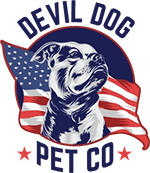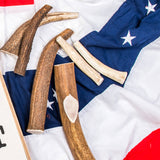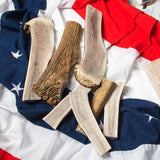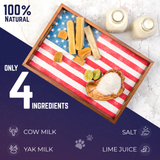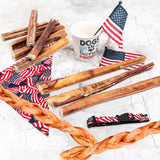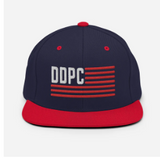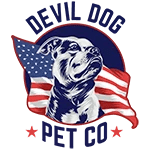Fluffy Dogs: Why They Capture Our Hearts and Test Our Leadership
There's something about a fluffy dog that commands attention. That plush, luxurious coat beckoning for your touch. Those expressive eyes peering through a curtain of fur. The irresistible urge to bury your face in their cloud-like softness. But as any seasoned dog owner knows, behind that Instagram-worthy floof lies a serious commitment—one that tests your leadership daily.
When our dog Dexter first joined our family, his moderate coat seemed manageable. Six months later, we were knee-deep in fur tumbleweeds and wrestling with matting issues we never anticipated. That journey taught us what we now preach at Devil Dog: exceptional dogs require exceptional leadership, especially when they're sporting a high-maintenance coat.
Whether you're considering adding a fluffy companion to your pack or already sharing your home with a furry tornado, understanding what you're signing up for isn't just smart—it's responsible ownership. Let's dive into the world of fluffy dogs, beyond the cuddle factor and straight into the leadership challenge they present.
The Fluffy Dog Appeal: More Than Just Good Looks

The attraction to fluffy dogs runs deeper than aesthetics. Studies show that petting soft fur triggers oxytocin release—the same bonding hormone that strengthens the connection between mothers and babies. That science explains why we're drawn to these walking teddy bears, but it doesn't prepare owners for what comes after the honeymoon phase.
Fluffy dogs come in every size category imaginable. From tiny Pomeranians weighing barely 7 pounds to massive Newfoundlands tipping the scales at 150 pounds, there's a fluffy breed that fits almost any living situation. But here's where many owners fail: assuming that size is the only consideration when selecting a fluffy companion.
The reality? A small fluffy dog like a Shih Tzu can demand more daily maintenance than a giant Pyrenees. The length, texture, and undercoat density matter more than the dog's overall size when calculating your grooming commitment. This is where your leadership journey begins—understanding that your dog's needs trump your aesthetic preferences.
Small Fluffy Dogs: Big Personalities in Compact Packages
Small fluffy dogs often become first-time owners' go-to choice. Their manageable size makes them apartment-friendly, and their portable nature means they can accompany you almost anywhere. But don't mistake their diminutive stature for low maintenance.
The Pomeranian, weighing just 3-7 pounds, sports a double coat that requires brushing every other day to prevent painful matting. These tiny fluffy dogs pack surprising energy into their small frames—physical and mental stimulation needs that many owners underestimate. Without proper leadership, these pint-sized fluffballs quickly develop "small dog syndrome," becoming reactive and difficult to manage.
Bichon Frises offer a hypoallergenic alternative for allergy sufferers seeking a small fluffy dog breed. Their curly white coats don't shed much but require professional grooming every 4-6 weeks plus daily brushing. Skip the maintenance, and you'll find yourself with a matted, uncomfortable dog and a hefty emergency grooming bill.
Shih Tzus, with their flowing double coats, present another popular option among small fluffy dog breeds. Originally bred as companions for Chinese royalty, they expect to be treated accordingly. Their flat faces make them prone to overheating, meaning summer coat management becomes a health issue, not just an aesthetic one.
Explore our Small Dogs Collection for products tailored to the needs of small fluffy breeds like Pomeranians and Shih Tzus.
Medium Fluffy Dogs: The Versatile Middle Ground
Medium fluffy dog breeds often strike the perfect balance between portability and substance. These dogs typically range from 25-50 pounds—substantial enough for hiking and outdoor activities but manageable in most living situations.
The American Eskimo Dog exemplifies the medium fluffy dog category with its pristine white coat and fox-like appearance. Don't let their good looks fool you—these dogs were bred as working companions with intelligence that demands engagement. Without proper leadership, that smart brain turns to destructive behaviors faster than you can say "where's my shoe?"
Keeshonds, with their spectacle-like facial markings and plush gray coats, represent another striking medium-sized fluffy dog. Originally bred as Dutch barge dogs, they're natural watchdogs with a tendency to alert-bark at everything from delivery drivers to falling leaves. Leadership here means teaching appropriate barking thresholds—a challenge many owners aren't prepared to tackle.
Medium fluffy dogs like the Shetland Sheepdog combine working intelligence with manageable size. Their herding background means they'll attempt to control movement in your household—children, other pets, even your guests—unless you establish clear boundaries. Their luxurious double coats shed profusely twice yearly, testing your commitment to both leadership and housekeeping.
For more detailed information on fluffy dog breeds, check out this comprehensive guide from AKC and Snouts N Stouts' fluffy dog breed list.
Find grooming tools and supplies perfect for medium fluffy dogs in our Medium Dogs Collection.
Big Fluffy Dogs: Gentle Giants with Massive Needs
Big fluffy dog types capture our imagination with their imposing presence and teddy bear appearance. But make no mistake—these are working breeds with specific purposes and needs that casual owners often fail to meet.
The Great Pyrenees, developed to guard livestock against predators, approaches life with independent decision-making and territorial instincts. Their massive white double coats shed like it's their job, creating fur drifts that will test your vacuum's limits and your patience. Without consistent leadership, these gentle giants develop guarding behaviors that become problematic in suburban settings.
Newfoundlands, with their waterproof coats and webbed feet, were bred for water rescue. These biggest fluffy dog breeds combine a sweet temperament with drool production that borders on legendary. Their black, brown, or landseer (black and white) coats require weekly brushing sessions that can take hours. Skip this maintenance, and you'll face matting so severe it requires sedation to address.
The Samoyed, with its distinctive white smile and plush coat, originated as a working sled dog in Siberia. These dogs need purpose—whether it's pulling a cart, participating in dog sports, or having a structured job around your home. Their thick double coats require consistent brushing to prevent painful hot spots, especially during seasonal blowouts when fur seems to come out by the handful.
For a broader look at fluffy dog breeds, including many large types, visit Bow Wow Insurance's list of 30 fluffy dog breeds.
Shop our Large Dogs Collection for products designed to support the grooming and care of big fluffy breeds like Newfoundlands and Great Pyrenees.
The Leadership Challenge of Fluffy Dogs
Regardless of size, fluffy dogs present unique leadership challenges. Their coats require consistent maintenance—not just for appearance, but for health. Matted fur pulls painfully on skin, creates breeding grounds for bacteria, and can cause overheating. As a leader, your job includes regular inspection and maintenance of this protective covering.
Many fluffy dog breeds were developed for specific working purposes, meaning they have hardwired behaviors that require channeling. Herding breeds may nip at heels, guardian breeds may be suspicious of strangers, and northern breeds may have high prey drives. Without leadership that acknowledges and addresses these instincts, you're setting both yourself and your dog up for failure.
The most common complaint we hear from overwhelmed owners? "I didn't know what I was getting into." That beautiful coat you fell in love with comes with responsibility—both in maintenance time and in understanding the breed's needs beyond the superficial. True leadership means researching before bringing home that fluffy puppy, not scrambling to address issues after they develop.
In Part 2, we'll explore the specific grooming needs of different fluffy dog types, from daily maintenance to seasonal considerations. We'll also dive into training approaches that work specifically for fluffy breeds, whose coat often makes traditional training tools less effective. Until then, remember—that gorgeous coat isn't just for your enjoyment. It's a responsibility you've taken on as your dog's leader and advocate.
The Grooming Reality: Beyond the Fluffy Facade

When you commit to a fluffy dog, you're signing up for more than adorable photo opportunities. You're enlisting in what military veterans like myself recognize as a maintenance operation that requires discipline, consistency, and proper equipment. Grooming isn't optional—it's mission-critical.
Most new owners of fluffy dogs underestimate both the time commitment and the technical skill required. That Samoyed or Pomeranian coat doesn't maintain itself. Depending on the breed, you're looking at anywhere from 30 minutes to several hours per week of active grooming time. Skip these sessions, and you'll face what we call "grooming bankruptcy"—a backlog of maintenance that often ends with an emergency shavedown at the groomer.
During my time in the Marines, we had a saying: "Proper preparation prevents poor performance." This applies perfectly to fluffy dog ownership. Invest in quality tools upfront—a high-velocity dryer, appropriate brushes for your dog's specific coat type, and proper shampoos and conditioners. This initial investment saves hundreds in emergency grooming sessions later.
Small Fluffy Dog Breeds: Maintenance Beyond Their Size
Small fluffy dog breeds often suffer the most from inconsistent grooming. Their compact size means mats form closer to the skin, creating painful pulling and potential skin infections. The tiny fluffy dog might look manageable, but their grooming needs are anything but small.
Maltese owners face the challenge of maintaining that iconic flowing white coat without daily brushing. The silky single-coat tangles easily, especially around collar areas and behind ears. Many owners eventually opt for a "puppy cut" maintenance trim, sacrificing some fluff for practicality.
Shih Tzus and Lhasa Apsos present similar challenges with their double coats. Without regular line-brushing (working through small sections at a time), these really fluffy dogs develop mats that fuse like armor plates. Their facial hair requires daily cleaning to prevent eye irritation and staining—a commitment many owners abandon within months.
Pomeranians, among the fluffiest dogs in the toy category, require specialized grooming knowledge. Their double coats should never be shaved—doing so can permanently damage their ability to regulate temperature and alter their coat texture forever. Instead, proper undercoat removal with appropriate tools preserves that signature pom-pom appearance.
Medium Fluffy Dogs: The Shedding Middle Ground
Medium fluffy dog breeds often combine the worst of both worlds—substantial undercoats that shed profusely and enough size to cover your entire home in fur. These breeds test your commitment to both regular brushing and environmental management.
The Australian Shepherd, with its gorgeous flowing coat, requires weekly brushing sessions at minimum. During seasonal blowouts, daily brushing becomes necessary to prevent fur tumbleweeds from colonizing every corner of your home. Their ear and leg feathering collects debris during outdoor adventures, requiring additional spot-cleaning.
Keeshonds and American Eskimo Dogs share that spitz-type double coat that seems designed for maximum shedding efficiency. These medium fluffy dogs need regular undercoat removal, especially during seasonal changes. Skip this maintenance, and you'll find yourself living in what looks like a gray or white snowstorm.
Shetland Sheepdogs combine a sensitive skin barrier with a thick double coat, making them prone to hot spots if grooming lapses. Their narrow muzzles and abundant neck fur often lead to food-related matting that requires daily attention. Without consistent leadership in maintenance, these medium-sized fluffy dogs quickly develop uncomfortable skin conditions.
Working with Fluffy Dog Types: Training Through the Floof
Training fluffy dogs presents unique challenges beyond the standard obedience curriculum. Their abundant coat often obscures body language cues, making communication more difficult in both directions. You can't see subtle muscle tension through all that fur, and they can't always feel gentle leash guidance.
Big fluffy dog breeds like the Great Pyrenees, Newfoundland, and Saint Bernard require clear, consistent training that accounts for their size and strength. Traditional training equipment often gets lost in their thick fur, requiring specialized tools and approaches. Their independent nature—bred for working without constant human direction—means training must emphasize reliability over rote obedience.
Very fluffy dogs of all sizes benefit from marker training that doesn't rely on physical prompts. Clear verbal cues and consistent rewards build communication pathways that work regardless of coat interference. This approach acknowledges the reality that you can't rely on collar corrections or subtle leash communication when working through inches of insulating fur.
Fluffy puppies present a special challenge—their adult coat hasn't developed yet, meaning training tools and approaches that work during puppyhood may need adjustment as their adult fluff emerges. Forward-thinking owners plan for this transition, gradually introducing tools and techniques that will remain effective through coat changes.
Seasonal Considerations for Fluffy Dog Breeds
The fluffiest dog breeds often struggle with seasonal challenges that require proactive leadership. Northern breeds with thick undercoats—Samoyeds, Alaskan Malamutes, American Eskimos—suffer tremendously in summer heat without proper coat management. Contrary to popular belief, shaving doesn't help and often makes overheating worse by removing their natural insulation system.
Instead, seasonal blowout assistance through high-velocity dryers and undercoat rakes helps these dogs shed their winter layer when temperatures rise. Air conditioning, cooling mats, and adjusted exercise schedules become necessary leadership decisions when you own a dog designed for Arctic conditions.
Winter brings its own challenges for fluffy medium-sized dogs and their smaller counterparts. Snow collects in their coat, forming painful ice balls between toes and along leg feathering. Preventative trimming of these areas shows leadership foresight, as does applying protective paw wax before winter outings.
The truly prepared owner of fluffy dog types maintains a seasonal calendar of coat management tasks—scheduling more frequent brushing during shedding seasons, adjusting bathing frequency based on outdoor conditions, and planning professional grooming appointments to align with seasonal needs.
Nutrition's Impact on Coat Quality
Leadership extends to nutrition decisions that directly impact your fluffy dog's coat health. The most beautiful, manageable coats grow from the inside out, fueled by appropriate nutrition that supports skin and hair follicle health.
Protein quality matters tremendously for maintaining coat integrity in all fluffy dogs breeds. Inadequate protein leads to brittle, breaking fur that mats more easily. Omega-3 and omega-6 fatty acids in proper balance support skin barrier function and coat luster—particularly important for single-coated breeds like the Maltese and Shih Tzu.
Many owners of really fluffy dogs discover that grain-inclusive diets often support better coat condition than grain-free options. The bioavailable nutrients in properly prepared grains contribute to the complex nutritional profile needed for optimal coat growth and maintenance.
Hydration plays an often-overlooked role in coat health. Dehydrated skin becomes flaky and irritated, leading to increased shedding and poor coat texture. Ensuring adequate water intake—through fresh water, moisture-rich foods, or even bone broth supplements—demonstrates another aspect of nutritional leadership.
The Mental Health Connection
The relationship between stress and coat health creates another leadership consideration for fluffy dog owners. Anxious dogs often over-groom, creating bald spots and texture changes that compound grooming challenges. Others develop stress-shedding patterns that intensify during periods of uncertainty.
Environmental enrichment, consistent routines, and appropriate exercise all contribute to mental stability that supports coat health. Many fluffy medium dogs and their larger counterparts were bred for specific jobs—herding, guarding, pulling—and become destructive without appropriate outlets for these drives.
Providing appropriate chew options like Devil Dog's elk antlers or yak chews gives fluffy dogs positive outlets for chewing energy that might otherwise be directed at self-grooming. These long-lasting options keep jaws busy and minds engaged without adding to the household mess.
The leadership lesson here is clear: mental health and physical appearance connect directly. The most beautiful fluffy dogs live in environments where their needs—physical, mental, and emotional—receive consistent attention from knowledgeable owners who understand the full picture of canine wellbeing.
In our final installment, we'll explore specific training techniques that work through the fluff, address common behavioral challenges in popular fluffy breeds, and provide a comprehensive shopping list for the prepared fluffy dog owner. Until then, remember that your leadership journey with your fluffy companion requires both heart and discipline—the perfect combination for success.
Training Through the Fluff: Specialized Techniques for Fluffy Dogs

When our dog Dexter was still learning the ropes, his fluffy coat created unique training challenges. Verbal commands became our primary communication tool since tactile feedback got lost in his abundant fur. This experience taught me that fluffy dogs require specialized training approaches that account for their physical characteristics.
For owners of very fluffy dogs, traditional collar corrections often disappear into the floof without registering. Instead, use front-clip harnesses that provide clearer directional guidance without relying on subtle neck pressure. These tools create unmistakable feedback that penetrates even the thickest coats of big fluffy dog types.
Hand signals prove invaluable when working with fluffy dog breeds. A customer with a Samoyed reported dramatic improvement in recall reliability after implementing distinct visual cues alongside verbal commands. This redundancy ensures your message gets through even when your dog's ears are partially covered by fur or environmental distractions compete for attention.
Breed-Specific Training for Small Fluffy Dogs
Small fluffy dog breeds often develop what trainers call "small dog syndrome"—a collection of behaviors stemming from inconsistent boundaries. These tiny fluffy dogs frequently get away with behaviors that wouldn't be tolerated in larger breeds simply because their size makes these behaviors seem less threatening.
Pomeranians and other small hairy dogs breeds benefit from clear structure and boundaries despite their diminutive size. Establish consistent rules about furniture access, greeting behaviors, and resource guarding from day one. Remember that these fluffiest dogs still need the security of knowing their place in your household hierarchy.
Bichon Frise and Maltese owners should focus on preventing separation anxiety through gradual alone-time training. These companion-bred fluffy puppies breeds often become overly attached without structured independence work. Start with brief separations and gradually increase duration while providing appropriate enrichment activities. For more in-depth guidance, see our article on dog breeds prone to separation anxiety.
For the Shih Tzu and similar small fluffy dog breeds, grooming desensitization becomes a crucial training focus. Daily handling sessions that include gentle manipulation of paws, ears, and face create a dog who accepts necessary maintenance without stress. This investment pays dividends throughout your dog's life. If you're struggling with grooming, check out our tips on trimming your dog's nails quickly.
Leadership Strategies for Medium and Large Fluffy Breeds
Medium fluffy dogs like the Keeshond and Australian Shepherd require substantial physical and mental exercise to prevent destructive behaviors. Their working heritage demands purpose—without it, that beautiful coat often ends up embedded in destroyed furniture or landscaping. For advice on managing shedding, read our effective tips to manage your pup's shedding.
For these medium sized fluffy dogs, implement structured daily routines that include both physical outlets and mental challenges. Scent work, puzzle toys, and training sessions that teach new skills provide the cognitive stimulation these intelligent breeds crave. A tired fluffy medium dog is a well-behaved one.
The biggest fluffy dog breeds—Newfoundlands, Great Pyrenees, and Saint Bernards—need early and consistent leash training that accounts for their eventual size and strength. A medium sized white fluffy dog may be manageable as a puppy, but becomes a formidable physical presence at maturity. Train loose-leash walking skills from the beginning, using appropriate equipment scaled to their substantial frames.
For guardian breeds like the Tibetan Mastiff or Great Pyrenees, socialization requires careful balance. These big fluffy dogs breeds need enough exposure to recognize normal versus threatening situations, but their natural protective instincts should be channeled rather than suppressed. Controlled introductions to various people, animals, and environments build discrimination skills without creating fearfulness. If your fluffy dog shows aggression, see our guide on addressing aggression with other dogs or people.
Addressing Common Behavioral Challenges in Fluffy Dogs
Excessive barking plagues many fluffy dog types, particularly spitz breeds like the American Eskimo, Keeshond, and Pomeranian. These alert watchdogs were often bred to announce potential threats, making noise control a significant leadership challenge. Implement "speak" and "quiet" commands early, rewarding silence as consistently as you'd reward any desired behavior.
Resource guarding appears frequently in fluffy dog breeds with working backgrounds. The Old English Sheepdog, Collie, and other herding-derived fluffiest dogs may guard food, toys, or even people without proper leadership. Address this through structured trading games and management techniques that prevent rehearsal of guarding behaviors.
Grooming avoidance becomes a self-perpetuating cycle with many fluffy dog breeds. The more a dog resists brushing, the more uncomfortable mats develop, making the next session even more unpleasant. Break this cycle through short, positive grooming interactions that end before your dog becomes stressed, gradually building duration as tolerance improves. For additional help, our article on dog diapers can be useful for managing grooming and hygiene in special cases.
Weather sensitivity affects many medium fluffy dog breeds and their larger counterparts. Northern breeds may refuse walks during summer heat, while small fluffy dogs often resist venturing out in rain or snow. Address these preferences through gradual acclimation and appropriate gear like cooling vests or weatherproof booties rather than forcing compliance. For seasonal safety, see our guide on keeping your dog safe during December's holiday cheer.
The Complete Fluffy Dog Shopping List
Successful fluffy dog ownership requires proper equipment. Start with grooming essentials: a high-velocity dryer ($150-300), slicker brush ($15-30), undercoat rake ($20-40), steel comb ($10-20), and detangling spray ($15-25). These investments prevent the far greater expense of emergency demat sessions at professional groomers.
For training, invest in a front-clip harness ($30-40), long-line training lead ($20-30), treat pouch ($15-25), and interactive toys ($15-50). These tools facilitate clear communication through the fluff while providing appropriate outlets for energy and intelligence.
Environmental management tools protect both your fluffy dog and your home. Consider elevated feeding stations ($30-50) to keep facial fur clean, washable furniture covers ($40-100), a quality vacuum designed for pet hair ($200-500), and appropriate containment options for when you're away. If your dog struggles with changes in routine, our article on helping your pup adjust to a quieter house offers helpful strategies.
Nutrition support includes omega-rich supplements ($25-40 monthly), appropriate protein sources (varies by brand), and durable chew options like Devil Dog's elk antlers or yak chews ($15-30). These investments maintain coat health from the inside out while providing appropriate outlets for chewing needs. To better understand your dog's emotional needs, read our post on how dogs express their affection.
Check out our Premium Elk Antler Dog Chews and Yak Cheese Himalayan Dog Chews for durable chew options that support mental health and dental care.
Building Your Fluffy Dog Support Network
Even with perfect preparation, fluffy dog ownership benefits from professional support. Establish relationships with a groomer experienced in your specific breed, a positive-reinforcement trainer familiar with fluffy dog challenges, and a veterinarian who understands breed-specific health concerns.
Connect with breed-specific online communities where experienced owners share solutions to common challenges. Whether you have a fluffy medium sized dog or a tiny fluffy dog, someone has already navigated the specific issues you'll face. These communities provide invaluable troubleshooting advice and moral support during difficult phases.
Consider investing in pet insurance that covers breed-specific concerns. Many fluffy dog breeds have predispositions to certain health conditions—hip dysplasia in larger breeds, patellar luxation in smaller ones, and skin issues across the spectrum. Appropriate coverage prevents financial constraints from limiting care options.
The Extreme Dog Leadership Approach to Fluffy Dogs
Successful fluffy dog ownership reflects the core of Extreme Dog Leadership: full responsibility, consistency, and care. These dogs aren't low-maintenance—they require time, grooming, training, and patience. Acknowledging this commitment early helps avoid disappointment or surrender later on. The reward is a visually stunning, behaviorally balanced dog who trusts and respects you. Just like in the Marine Corps, leadership means putting your dog's needs first.
There will be tough days, but consistency—not perfection—defines your success. Whether you own a giant fluffy breed or a toy-sized puffball, the principles stay the same: lead with clarity, meet their needs, and build skills over time. In doing so, you’ll earn the loyalty and love these dogs are known for.
Download the FREE 10-Step Dog Prep Guide
Frequently Asked Questions
What breed of dog is very fluffy?
Breeds like the Samoyed, Pomeranian, and Chow Chow are known for their exceptionally fluffy coats. These dogs have thick double layers of fur that give them a soft, plush appearance. Fluffy breeds often require regular grooming to keep their coats healthy and free of mats.
Are Samoyeds good dogs?
Yes, Samoyeds are known for being friendly, gentle, and highly social dogs. They are great with families and children due to their affectionate and playful nature. However, they are also energetic and require plenty of exercise and mental stimulation to stay happy.
What is the top 10 cutest dog?
While 'cutest' can be subjective, popular choices often include breeds like the Pomeranian, French Bulldog, Cavalier King Charles Spaniel, Shih Tzu, Corgi, Dachshund, Maltese, Bichon Frise, Pug, and Pembroke Welsh Corgi. These breeds are loved for their charming looks and friendly personalities. Each has unique traits that appeal to dog lovers around the world.
What is the big shaggy dog?
The Old English Sheepdog is a classic example of a big shaggy dog, known for its thick, shaggy coat that covers its eyes and face. Another example is the Komondor, famous for its corded, mop-like fur. These dogs have a distinctive, fluffy appearance that makes them stand out in a crowd.
What is the cutest small fluffy dog?
Many consider the Pomeranian to be the cutest small fluffy dog due to its tiny size and abundant, puffy fur. Other contenders include the Toy Poodle and the Bichon Frise, both of which have soft, curly coats and friendly dispositions. These breeds are perfect companions for those looking for a small, adorable, and fluffy pet.
What dog has big fluffy fur?
Dogs like the Alaskan Malamute and the Samoyed are well-known for their big, fluffy fur that keeps them warm in cold climates. Their dense double coats are thick and plush, giving them a majestic and cuddly appearance. These breeds require regular grooming to maintain their fluffy coats in top condition.
What are the fluffiest dogs?
The fluffiest dogs include breeds like the Samoyed, Chow Chow, Alaskan Malamute, Pomeranian, Husky, and Shiba Inu. These dogs are known for their thick, dense coats that require regular grooming to keep them looking their best.
